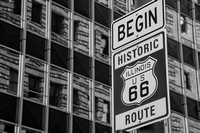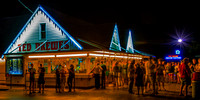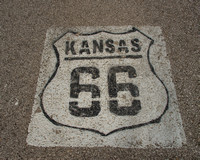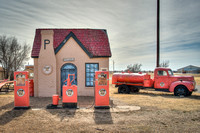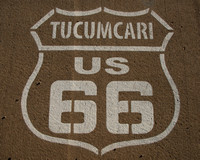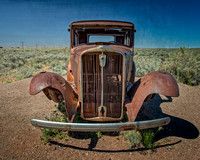Get Your Kicks on Route 66!
The "Mother Road", US Route 66, had its beginnings in the summer of 1926, after legislation to create a national highway system became a reality. At the time, most small towns had no access to a national road system. The goal of Route 66 was to connect rural and urban communities. It pieced together existing roads and trails across eight states, from Chicago to Los Angeles. Although most roads were eventually paved, many began as dirt paths. Some turned into 2-lane highways; others turned into 4-lane superhighways. The Interstate Highway System began to take over in the late 1950s. In 1984, the route was de-certified as a US highway and many businesses abutting the highway closed their doors, but its historical significance lived on. Today, people travel the highway for the nostalgia of the past.
My interest in Route 66 began when one of my sons decided to attend the University of Tulsa. I would be traveling the route quite a bit. Why not stop and take pictures along the way? As I've researched sites along the route, my interest has grown. On my trips to visit my son, I began travelling a bit beyond Tulsa before heading back home. Then, I had the opportunity to help a friend move across country to LA County. So, I now have pics from all eight states! That doesn't mean I will stop. As I travel through these states in the future, I plan to be on the lookout for new sites of interest.
Note that Route 66 is not always an easy route to follow. In deciding where to stop, I have been relying on two travel guides: (i) "EZ66 Guide for Travelers", 3rd edition, by Jerry McClanahan; and (ii) "Road Trip USA Route 66", by Jamie Jensen. Remember that the initial goal of the route was to connect existing roadways of rural and urban towns and communities. So, if you want to drive the actual route the entire way (as opposed to the Interstate that abuts large pieces of the route), know that the path winds off in many directions when it goes through these smaller towns. I have found pre-1932 routes, pre-1937 options, post-1954 paths, pre-1958 routes, etc. Dirt paths remain in areas. Some are not always passable.
Growing up in St. Louis, I had always heard that nearby Watson Road was the east/west path that led Route 66 travelers through the city. Then, I realized that Manchester Road (also running east/west) was a path as well. Because of the wide number of arteries and the fact that the "official" route was changed routinely, the route can be very confusing. Click to learn more about 66 through St. Louis.
As for my photo galleries, I've included sites along roads that were a part of Route 66 at any point in its history. I've included a few attractions just off the route as well, especially those attractions frequented by travelers taking a break from their journeys. For example, crossing Illinois into Missouri, one of the first diners that travelers would find was Crown Candy Kitchen in Old North St. Louis. I've included photos even though it is actually 2 blocks off the route.
As mentioned, I've been learning quite a bit about the route and its history. The most surprising piece of information came to me while visiting a Missouri History Museum exhibit (St. Louis, MO): "Route 66: Main Street Through St. Louis", June 25, 2016 - July 16, 2017. The exhibit brought to my attention an important fact about the Route that many Americans overlook; that is, that Route 66 is primarily celebrated by white America. The route connected white communities across our country, from Chicago to Los Angeles. Black America was largely shunned in the process. The vast majority of motels, dining establishments, gas stations and other businesses along the route refused to serve black travelers who stopped. Traveling the route could be dangerous, or sometimes even fatal, for these travelers. A New Yorker from Harlem recognized this fact and created a guide book to assist black Americans, "The Negro Motorist Green Book", by Victor H. Green. The book was used widely between the years of 1936-1964, providing black travelers with a list of safe business establishments that would welcome them along the route. These businesses were taking a huge risk in allowing their names to be listed in the book, but they did so nonetheless. While Route 66 holds nostalgia for so many, I felt it important to point out the obstacles that a significant portion of our population faced while traveling the "Mother Road".
To learn more about the Green Book, click on the video link.
Click the following for a more detailed history of Route 66.
Click the following for Route 66 maps.
The "Mother Road", US Route 66, had its beginnings in the summer of 1926, after legislation to create a national highway system became a reality. At the time, most small towns had no access to a national road system. The goal of Route 66 was to connect rural and urban communities. It pieced together existing roads and trails across eight states, from Chicago to Los Angeles. Although most roads were eventually paved, many began as dirt paths. Some turned into 2-lane highways; others turned into 4-lane superhighways. The Interstate Highway System began to take over in the late 1950s. In 1984, the route was de-certified as a US highway and many businesses abutting the highway closed their doors, but its historical significance lived on. Today, people travel the highway for the nostalgia of the past.
My interest in Route 66 began when one of my sons decided to attend the University of Tulsa. I would be traveling the route quite a bit. Why not stop and take pictures along the way? As I've researched sites along the route, my interest has grown. On my trips to visit my son, I began travelling a bit beyond Tulsa before heading back home. Then, I had the opportunity to help a friend move across country to LA County. So, I now have pics from all eight states! That doesn't mean I will stop. As I travel through these states in the future, I plan to be on the lookout for new sites of interest.
Note that Route 66 is not always an easy route to follow. In deciding where to stop, I have been relying on two travel guides: (i) "EZ66 Guide for Travelers", 3rd edition, by Jerry McClanahan; and (ii) "Road Trip USA Route 66", by Jamie Jensen. Remember that the initial goal of the route was to connect existing roadways of rural and urban towns and communities. So, if you want to drive the actual route the entire way (as opposed to the Interstate that abuts large pieces of the route), know that the path winds off in many directions when it goes through these smaller towns. I have found pre-1932 routes, pre-1937 options, post-1954 paths, pre-1958 routes, etc. Dirt paths remain in areas. Some are not always passable.
Growing up in St. Louis, I had always heard that nearby Watson Road was the east/west path that led Route 66 travelers through the city. Then, I realized that Manchester Road (also running east/west) was a path as well. Because of the wide number of arteries and the fact that the "official" route was changed routinely, the route can be very confusing. Click to learn more about 66 through St. Louis.
As for my photo galleries, I've included sites along roads that were a part of Route 66 at any point in its history. I've included a few attractions just off the route as well, especially those attractions frequented by travelers taking a break from their journeys. For example, crossing Illinois into Missouri, one of the first diners that travelers would find was Crown Candy Kitchen in Old North St. Louis. I've included photos even though it is actually 2 blocks off the route.
As mentioned, I've been learning quite a bit about the route and its history. The most surprising piece of information came to me while visiting a Missouri History Museum exhibit (St. Louis, MO): "Route 66: Main Street Through St. Louis", June 25, 2016 - July 16, 2017. The exhibit brought to my attention an important fact about the Route that many Americans overlook; that is, that Route 66 is primarily celebrated by white America. The route connected white communities across our country, from Chicago to Los Angeles. Black America was largely shunned in the process. The vast majority of motels, dining establishments, gas stations and other businesses along the route refused to serve black travelers who stopped. Traveling the route could be dangerous, or sometimes even fatal, for these travelers. A New Yorker from Harlem recognized this fact and created a guide book to assist black Americans, "The Negro Motorist Green Book", by Victor H. Green. The book was used widely between the years of 1936-1964, providing black travelers with a list of safe business establishments that would welcome them along the route. These businesses were taking a huge risk in allowing their names to be listed in the book, but they did so nonetheless. While Route 66 holds nostalgia for so many, I felt it important to point out the obstacles that a significant portion of our population faced while traveling the "Mother Road".
To learn more about the Green Book, click on the video link.
Click the following for a more detailed history of Route 66.
Click the following for Route 66 maps.
© Anne Warfield Photography & Digital Art

